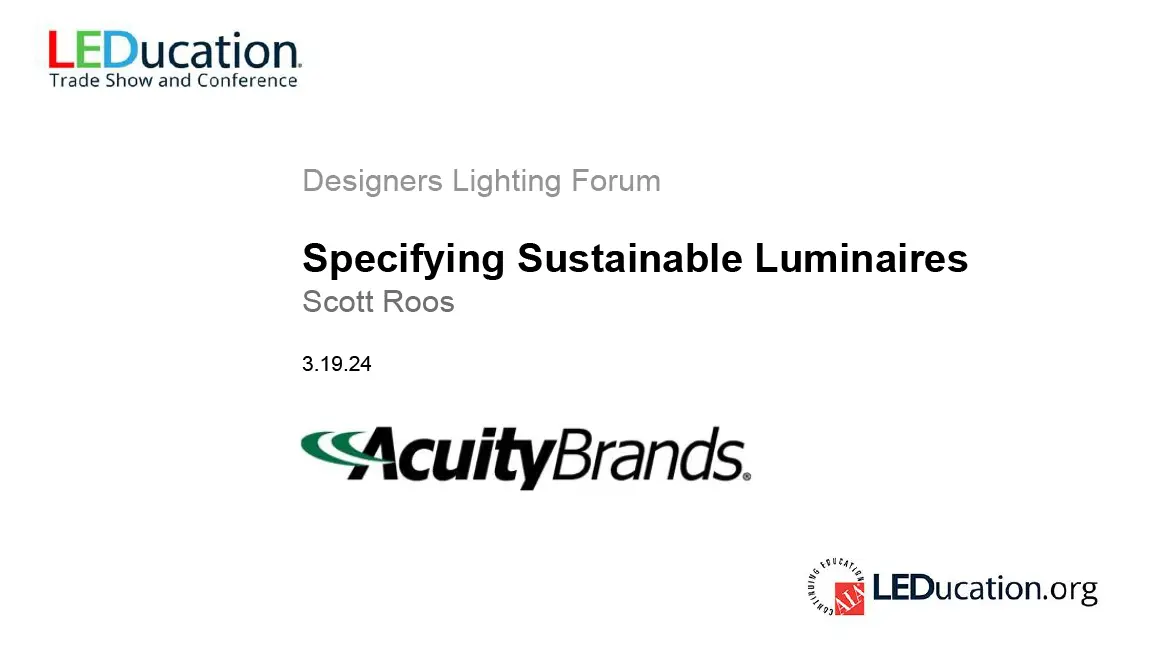Scott Roos, Acuity Brands
Location: Murray Hill
TuesdayMarch 19, 2024
2:00 pm - 3:00 pm EST
Credits 1 LU | Elective
Introductory
This fact-filled presentation provides an overview of the elements of sustainability and how to best specify sustainably designed luminaires. By providing an in depth understanding of what each element is and how it can be best assessed, evaluated and compared, a blueprint will be provided for how to identify, select and apply the most sustainable luminaires in your projects. The presentation will highlight gaps and emerging solutions in the design, application and assessment of sustainable luminaires. Be prepared, some of the material may challenge your thinking as to what aspects of a luminaire really have the biggest environmental impact!
A basic understanding of specifying luminaires for projects is helpful, but not necessary for this presentation.
Learning Objectives
- Recognize the key elements of sustainability & their impacts including Embodied & Operational Carbon, Materials Responsibility & Workplace Social Responsibility
- Understand the various methods of assessing sustainability including Circular Design, Life Cycle Assessments and Materials Transparency
- Gain a working knowledge of the luminaire related sustainability requirements of WELL, LEED and The Living Building Challenge
- Apply the principals discussed to specify the most environmentally responsible lighting equipment for your project.

Speaker

Scott Roos is the Vice President, Sustainability and Business Optimization, Specialty Lighting Group at Acuity Brands. 2024 marks Scott's 46th year in lighting, a career that has encompassed product design, marketing, product management, strategic planning and lighting education. Products Scott has worked on have earned numerous patents and awards including the Industrial Design Excellence Award and LightFair's Most Innovative Product and Technical Innovation awards. He has also developed the concepts and lighting design for numerous facilities, showrooms and tradeshow booths including the acclaimed Des Plaines, IL Center for Light and Space.
Scott has always been involved in pushing the envelope for critical topics of the time, from developing the first miniature low voltage accent lighting fixtures and systems in the 80’s to helping advance CFL general illumination downlighting in the 90s to driving the development of the first commercially viable LED track and recessed solutions in the early 2000s. Most recently Scott has been a grain of sand in the oyster to encourage us to embrace wellness and sustainability as fundamental elements of good lighting and has been a regular speaker on both topics at national and regional industry events.
He is currently serving as a member of the IES Sustainability Committee, which is updating the LP10 Sustainable Lighting Practice document, the NEMA Lighting Sustainability Task Force, the International Electrotechnical Committee (IEC) addressing the Environmental Aspects of Lighting and with Smart EPD to develop Product Category Rules for conducting luminaire Life Cycle Assessments in North America.
Scott has a BFA in Industrial Design from the University of Illinois and an MBA from De Paul University.
